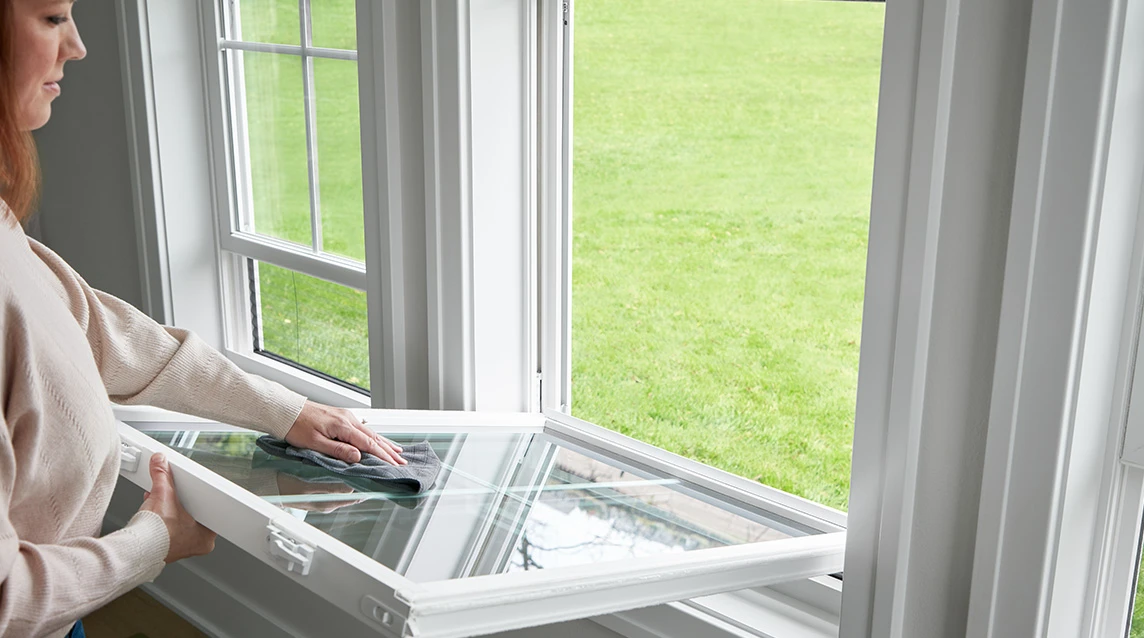
Learn how to properly clean every part of your windows and keep them looking great for years to come.
We’re diving into the details of window cleaning. From the best homemade window cleaning solution to the proper way to clean your window screens and frames, we’ll help you get those windows looking beautiful.
While it’s not a glamorous job, window cleaning is an important part of home maintenance. If you’ve been wondering how to clean windows quickly and efficiently, we’ve got you covered with our favorite tips and tricks to help you keep your windows looking great for years.
You can clean your windows with an ammonia-free glass cleaner, like a premixed vinegar-based cleaning solution, or you could make your own. Avoid using window glass cleaners that are ammonia- or alcohol-based as they may leave streaks or produce a film that attracts moisture or dust. If you choose to make your own cleaner, here’s an easy homemade window cleaning solution you’ll want to keep bookmarked:
Mix one cup white vinegar with 10 cups of water. Fill a spray bottle with the mixture, and store leftover cleaner in a jug for future use.
Apply your cleaning solution to a soft, clean, lint-free microfiber cloth or paper towel. Feel free to be generous with the amount of cleaner you apply to the cloth or paper towel, but avoid getting any cleaning solution on the wood, fiberglass or vinyl frames, as it may discolor the finish.
We recommend cleaning windows at least twice a year for optimal quality, but you can clean them as often as once a month if you like. Before you get started, you’ll want to make sure you have all the necessary materials. A soft, lint-free towel, such as an old kitchen towel, linen napkins or a made-for-glass microfiber cloth, is the best thing to clean windows. You’ll also need a vinegar-based cleaning solution (like the recipe listed above), non-abrasive cleaner, soap, water and a vacuum with a soft brush and drapery attachments for interior and exterior window cleaning.

Regardless of whether you have a double-hung, casement or some other type of window, to begin cleaning, use a brush or vacuum to sweep dirt from the window or door frame. Next, effortlessly remove marks and smudges from your windows and doors by applying a small amount of nonabrasive cleaner to a clean, wet cloth. You can also apply a solvent like acetone or mineral spirits to a clean, dry, lint-free microfiber cloth. Rub the cloth on the areas of glass that need spot-cleaning, but rub carefully and avoid getting cleansers or solvents on the wood, fiberglass or vinyl frames, as they may discolor the finish.
After rubbing the glass, wipe clean by using a clean, dry lint-free cloth. Pro tip: Never use a razor blade to scrape off stubborn materials and use care if using a squeegee. Razor blades or squeegee edges may leave permanent marks or scratches on the glass.
If you have double-hung windows, tilting the sashes in makes it easy to clean exterior surfaces from the interior of your home. We recommend cleaning the top sash first, starting with the exterior and followed by the interior, and then repeating the same process on the lower sash. Watch our step-by-step video to learn more about window washing for easy-clean double-hung windows.
When it comes to cleaning window and door frames, avoid power washing. Use warm, soapy water on a rag and stay away from abrasive chemicals that may discolor the window frame finish. Stubborn stains and deposits may be removed with mineral spirits or cleaning solution like Pine-Sol® and can be applied with a clean, dry cloth or towel.
The best way to clean window screens and remove dust and dirt is to vacuum them with an upholstery brush attachment. For grease spots, typically found on kitchen window screens, use a sponge, hot water and a mild detergent. For a flat screen, like those found on a window, storm door or patio door, remove the screen and wash with soap and water. Rinse and repeat as needed to clean. Or, use a drapery brush attachment on a vacuum. Remember to be gentle, as aluminum screens can bend very easily.
For wood window blinds made from wood, regular dusting will help them maintain a like-new appearance. When deeper cleaning is needed, vacuum gently with the soft brush attachment. If you have plastic or metal blinds, immerse blinds in a tub of lukewarm water and mild detergent. Then, rinse with clear water, and let air-dry before reinstalling. For fabric blinds or shades, you can use a vacuum cleaner with a drapery brush attachment to remove dust and a damp cloth to remove smudges, fingerprints, etc.

Learn how to properly clean every part of your windows and keep them looking great for years to come.

Follow this step-by-step process for guidance on how to replace windows, from beginning to end.

Replacement windows offer more than natural light and a refreshed look. Read about the benefits of new or replacement windows below and learn how you can get most out of your investment.